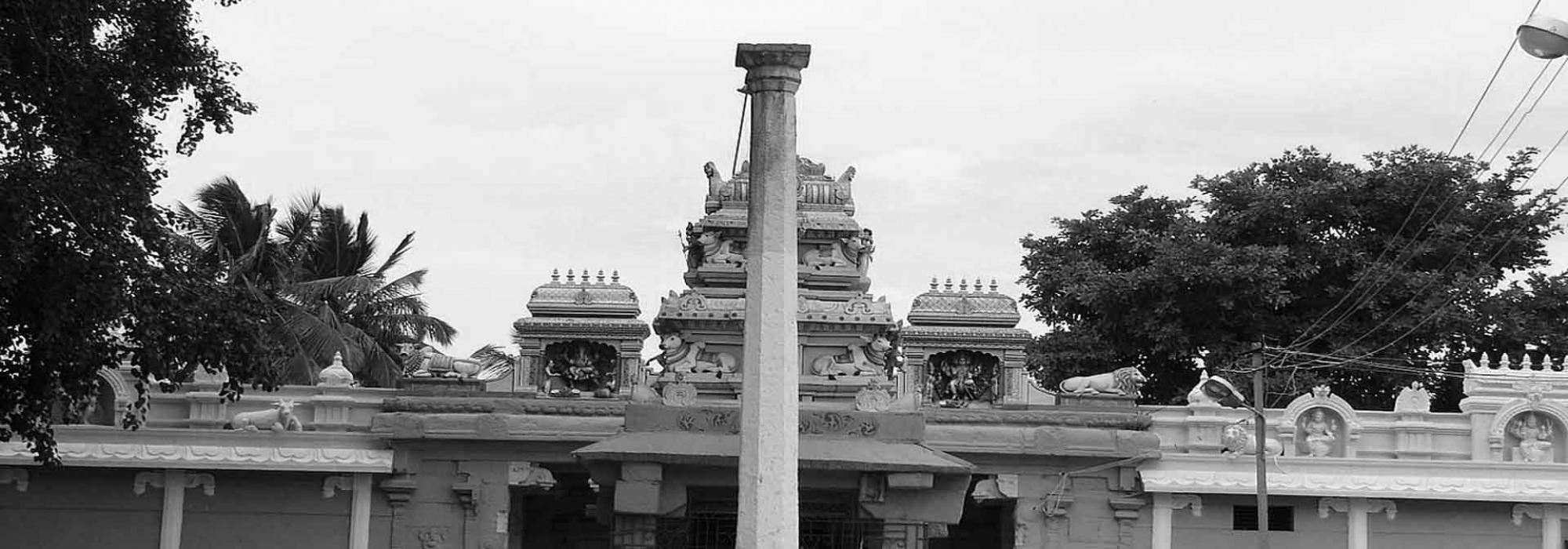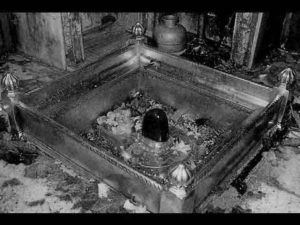- 1 -
Sri Subbabhatta
Mulabagal Sri Subbabhatta hailed from a lineage of Raja Purohitas (Royal Purohitas) and belonged to the Badaganadu subsect. He was younger to Sri Venkatarama Bhatta. He was a Rg Vedin but still studied Jyotisha and Dharmashastras under the tutelage of Sri Venkatarama Bhatta, who was a Yajur Vedin. His house neighbored that of Sri Venkatarama Bhatta.
There were about six or seven Smarta[i] homes and about two hundred and fifty or three hundred Madhva homes in that town. There was absolutely no Srivaishnava home except those who arrived there on temporary government duty. These Smarta homes hailed from four different subsects: Mulakanadu, Badaganadu, Seeranadu, and Dravida. Despite this, everyone lived as one family. Of these, the homes of Sri Venkatarama Bhatta, Sri Subbabhatta and ours formed a cluster. If any special occasion or function occurred in any of these houses, the members of all the three families would assemble in that home.
Sri Subbabhatta lost his father during his childhood. His father’s younger brother, Sri Krishanmbhatta took care of the family. Sri Subbabhatta’s mother was Srimati Chennamma, his elder sister was Venkamma and his younger sister was Venkatalakshamma. The man who grinded his entire life to ensure a good future for this family was Sri Krishambhatta.
- 2 -
Sri Krishambhatta
It is necessary to narrate Sri Krishambhatta’s life story. He remained a strict and true Brahmacharin till the end of his life. In a niche in his living room, there was a stone sculpture of Ganapati, an ancestral heirloom. After waking up in the morning, the first thing that Sri Krishnambhatta would do was to light the lamp to that Ganapati, offer flowers, chant stotrams and then proceed with the day’s work.
Until Sri Subbabhatta came of age and attained maturity, Sri Krishanmbhatta used to perform Pourohitya. That was the Pourohitya of the market or the business community. The income that ensued from it was sufficient for their family in that era. They also had some land.
Sri Krishnambhatta typically finished his Pourohitya at ten or eleven and return home and take a bath again—in cold water. This was followed by the daily puja at home. Nobody would tell Sri Krishnambhatta to hurry up citing the excuse that it was getting late. He would methodically and slowly chant the Mantras without committing any error in the Swaras.
Post lunch, he would visit Sri Venkatarama Bhatta’s home. After spending about a half hour there, he would head out to various homes in the town and perform the Panchanga Shravana[ii]. He would return home in the evening and perform the Sandhyavandanam and Deeparadhana. Then he would go to the Kashi Visweshwara temple and sleep in the Mantapam there. He didn’t eat at night and would awake at dawn. This was his daily routine.
The personal discipline he had set for himself: to stay away from home as much as possible but to never forget the responsibilities he had towards home. He was completely pure, inside out, akin to a Rishi.
Sri Krishnambhatta didn’t show negligence towards kids. Before I reached an age where I could realize his greatness, I joined kids of my age and composed parody poems on his name and sung them loudly. He would join our party and laugh with us, and if there was an error in the wording of a poem, he’d correct it.
My namaskarams to his sacred memory.
Spirit of Inquiry
Sri Subbabhatta was deeply traditional and possessed a calm and gentle disposition. He was in my father’s circle of close friends. If he was struck with something that worried him, he’d call out, “hey Subba,” and seek his advice. He didn’t display a sense of over-smartness; his mind was free from any taint.
He was akin to a true friend to me and worthy of reverence. Among others, he was one who guided me, corrected me. My father believed that I would listen only to Sri Subbabhatta’s words when the efforts of others had failed. It was mostly an accurate belief.
Sri Subbabhatta possessed a spirit of rational inquiry. He had a good understanding of the principles of the Theosophical Society. He would discuss their opinions with me. Sri Subbabhatta was the one who first introduced me to the Vajrasoochikopanishad.
Sri Subbabhatta passed away before he turned sixty. But he remains alive in the memories of everyone who knew him.
- 3 -
Sri Shyamabhatta
He was a Rigvedin belonging to the Seeranadu subsect. Not only was he deeply learned, he was an expert in performing both the Poorva and Apara ceremonies[iii]. He was a strict adherent of Karma.
Sri Shyamabhatta’s elder son Vamanabhatta and I were of the same age. Both our thread ceremonies took place on the same day. Sri Shyamabhatta was considerably well off. He owned a house and had some land. He managed all of his financial affairs with great competence and intelligence. He never sought any benefit from anybody.
Each time his memory surfaces, the most praiseworthy facet that stands out is the Phalahara Puja [literally, Puja performed with offerings of fruits] that used to take place in his home on every Dwadashi (twelfth day). About ten or fifteen Brahmanas would be present. Elaborate Veda Ghosha (chanting the Vedas) would take place till about two or two-thirty in the afternoon.
Then the Phalahara Puja would commence.
Four varieties of Avalakki; puffed rice laddoos; a vast array of sandige; rasayana or fruit salad; kosumbari—and several other delicacies. At the end, he would offer the Dakshina. After the elders had finished eating this Phalahara, they would loudly proclaim, “Sri Rama is now content,” rubbing their bellies. As they prepared to leave, Sri Shyamabhatta’s consort, Srimati Narasamma would signal to me, “you sit here for a bit.” Round Two of my Phalahara would commence. She knew that I was a bit of a glutton.
Sri Shyamabhatta was a gentle benefactor who led a spotless life.
- 4 -
Hebbani Sri Ramachandra Shastri
He hailed from the Mulakanadu subsect. He had a great mastery over the Ramayana, Mahabharata and Bhagavatam. His skin tone was flawless, he had an excellent physique and a pleasing voice. Together with these qualities, he was endowed with a pure conduct and tranquil character.
Hebbani is a village situated about fifteen or twenty miles from Mulabagal. It appears that it had been populated by a great number of Vidwans in the past. A renowned Vedic Vidwan named Sripati Bhatta had lived there. Several of the great Madhva scholars who settled in Mulabagal originally hailed from Hebbani. Hebbani Seshacharya, Hebbani Srinivasacharya, and Hebbani Ramannacharya were among the notables.
Sri Ramachandra Shastri would visit Mulabagal to recite the Puranas. The recitation was in Telugu. The Telugu poet Potana’s Bhagavatam and the Ranganatha Ramayana were his primary texts. Sri Shastri would select some portion, set it to a raga and sing it aloud. Then he would expound on its meaning in detail. His dazzling oratory, the vivid style of description and his facial expressions and hand gestures that matched them—all this mesmerized the audience. Typically, his Purana session lasted from seven-thirty or eight in the evening to ten-thirty or eleven in the night. He concluded the session with a poem whose meaning can be summarized thus:
Today’s session was made possible because of the munificence of Sri X. God will bless the magnanimity of the person who will make tomorrow’s session possible.
The word “session” in this case meant Naivedya offered both in the morning and evening.
As soon as he finished this poem, the Vaishyas would come forward eager to be the first to offer their Naivedya. The Purana session would take place in the marketplace, amidst the Vaishya Mandali. The Vaishyas of that town were wealthy. And attached to Dharma.
Sri Ramachandra Shastri would stay at our home. He has given me immense joy by narrating countless stories and Upakhyanas. Some of the stories that he narrated from the Mahabharata have supplied extraordinary mental strength during testing times in my life.
This is the English translation of the fourth chapter of D V Gundappa’s Jnapakachitrashaale: Vol. 5 – Vaidikadharma Sampradayastharu.
Notes
[i] Smarta is one of the main sects among Brahmins who follow the Advaita Vedanta school of Adi Shankara. Other sects include Madhva and Srivaishnava who respectively adhere to the traditions propounded by Sri Madhvacharya and Sri Ramanujacharya.
[ii] A practice of reciting aloud the current year’s fortunes as recorded in the Panchangam or the Hindu almanac. This includes things like ratio of income and expenses for all moon signs, good and bad occurrences, taxes and so on.
[iii] Poorva ceremonies typically include ceremonies and rituals performed on auspicious occasions such as the naming ceremony, wedding, and even general occasions such a Yaga, Puja and so on. Apara ceremonies include any ritual ranging from the death ceremony to the annual death rites or Shradda.















































